CP grade 12 - Blackhawk School District
CP grade 12 - Blackhawk School District
CP grade 12 - Blackhawk School District
Create successful ePaper yourself
Turn your PDF publications into a flip-book with our unique Google optimized e-Paper software.
<strong>Blackhawk</strong> <strong>School</strong> <strong>District</strong><br />
CURRICULUM<br />
Course Title: College Preparatory English <strong>12</strong><br />
Course Number: 0154<br />
Grade Level(s): <strong>12</strong><br />
Periods Per Week: 5<br />
Length of Period: 42 minutes<br />
Length of Course: Year long<br />
Credits: 1<br />
Faculty Author(s): Cheryl Nicely, Marion Moore and Anita Steppe<br />
Date: May 2008, Revised February 20<strong>12</strong><br />
COURSE DESCRIPTION:<br />
This survey course of world and English literature is for college bound students. The course focuses on major authors and their works, tracing the<br />
development of world literature from the Ancient Greeks to the 21 st century. The English literature component traces the development of English<br />
literature from the Anglo-Saxon period to present day. Students use the writing process to produce narrative, informational, persuasive and creative<br />
pieces. Students respond to fiction, non-fiction, poetry and drama using interpretive, critical and evaluative processes.<br />
Teacher recommendation is required for this course.<br />
1
ESSENTIAL QUESTIONS:<br />
Essential questions are the heart of the curriculum. Essential questions are conceptual commitments that teachers will use to guide instructional<br />
decision-making. In addition, they are kid friendly so that students can easily understand them. Essential questions are meant to be shared with<br />
students in either discussion or posting in the classroom. Essential questions provide the focus for teaching and learning.<br />
Assessing Essential questions is key to a robust curriculum. If Essential Questions are the focal point of learning, how then do we assess students?<br />
The following are the Essential Questions for this class and an overview of recommended assessments to the Essential Questions. In addition,<br />
Differentiated learning opportunities are embedded as well (noted by DI).<br />
Night<br />
1. Have you ever been discriminated against? For what reason(s)? Please explain.<br />
2. How would you place a value on a human life?<br />
The Inferno<br />
1. Have you ever been accused of a crime/wrong doing? Were you justly or unjustly accused?<br />
Did the punishment you received fit the crime? Explain.<br />
Macbeth<br />
1. Does nature or nurture determine a person’s destiny?<br />
Is Macbeth’s tragic flaw a result of his nature?<br />
Is Macbeth’s tragic flaw result of nurture?<br />
2. How do we achieve our ambitions without sacrificing our virtues? Can we get what we<br />
want without sacrificing who we are?<br />
2
ROBUST VOCABULARY:<br />
Robust vocabulary words are Tier 2 words, meaning that they are complex, powerful, and generalizable. Robust vocabulary words support language<br />
development of both lower and high level learners. In addition, robust vocabulary instruction helps prepare students for SATs, upper level high<br />
school classes, and college. “Studies showed that robust instruction was quite effective not only for learning the meanings of words but also for<br />
affecting reading comprehension.” (p. 2 Bringing Words to Life).<br />
Teachers are asked to commit to teaching and students USING these words throughout the entire year. Using a variety of instructional strategies,<br />
students will learn the meaning of these words in a deep and meaningful way in this content and across other content areas.<br />
The Robust Vocabulary for this class are:<br />
Night<br />
1. ignominious<br />
2. abstruse<br />
3. heinous<br />
4. interminable<br />
5. hapless<br />
6. eschew<br />
7. forsake<br />
8. enmity<br />
9. exacerbate<br />
10. disparage<br />
The Inferno<br />
1. austere<br />
2. commensurate<br />
3. nefarious<br />
4. avarice<br />
5. contrite<br />
6. disdain<br />
7. bereft<br />
8. despondent<br />
9. cognizant<br />
10. impute<br />
3
Macbeth<br />
1. abet<br />
2. iniquity<br />
3. egregious<br />
4. cogent<br />
5. façade<br />
6. mendacious<br />
7. debacle<br />
8. portent<br />
9. guile<br />
10. temerity<br />
4
Fiction<br />
COURSE OUTLINE<br />
Literary Terms/Figurative<br />
Language 1.3.11.C 1.3.11.D<br />
R11.B.2.1.1 R11.B.2.1.2<br />
OBJECTIVES (PA standard)<br />
1.3.11.C. Analyze the effectiveness, in terms of literary<br />
quality, of the author’s use of literary devices such as:<br />
sound techniques (e.g., rhyme, rhythm, meter,<br />
alliteration); figurative language (e.g., personification,<br />
simile, metaphor, hyperbole, irony, satire); literary<br />
structures (e.g., foreshadowing, flashbacks, progressive<br />
and digressive time).<br />
1.3.11.D. Analyze and evaluate in poetry the<br />
appropriateness of diction and figurative language (e.g.,<br />
irony, understatement, overstatement, paradox.).<br />
PROPOSED<br />
TIME<br />
20 days<br />
RESOURCES<br />
Odyssey<br />
translated by<br />
EV Rieu l946<br />
Penguin<br />
Classics<br />
ISBN: 00-069-<br />
8255<br />
Macbeth<br />
Folgers/Perma<br />
Bound, 1992<br />
LESSON REFLECTION<br />
(for future revisions)<br />
Character<br />
1.3.11.B R11.B.1.1.1<br />
R11.B.2.1.1 Identify, interpret, describe, and or<br />
analyze examples of personification, simile, metaphor,<br />
hyperbole, satire, imagery, foreshadowing, flashbacks<br />
and irony in text.<br />
R11.B.2.1.2 Identify, interpret, describe, and/or<br />
analyze the author’s purpose for and effectiveness at<br />
using figurative language in text.<br />
1.3.11.B. Analyze the relationships, uses and effectiveness<br />
of literary elements used by one or more authors in similar<br />
genres including characterization, setting, plot, theme,<br />
point of view, tone and style.<br />
Inferno<br />
translated by<br />
John Ciardi<br />
1952-1982<br />
Permabound<br />
Selections<br />
from World<br />
Literature<br />
Holt, Rinehart<br />
Winston1998<br />
ISBN: 03-051-<br />
408-6<br />
R11.B.1.1.1 Interpret, compare, describe, analyze,<br />
and/or evaluate character actions, motives, dialogue,<br />
emotions; feelings, traits, and relationships among<br />
characters with fictional or literary nonfictional text.<br />
-Interpret, compare, describe, analyze, and/or evaluate<br />
the relationship between characters and other<br />
components of text.<br />
1.3.11.B Analyze the relationships, uses and effectiveness<br />
of literary elements used by one or more authors in similar<br />
genres including characterization, setting, plot, theme,<br />
5<br />
Selections<br />
from<br />
Adventures in<br />
English<br />
Literature<br />
Holt, Rinehart<br />
Winston 1998<br />
0-03-098639-7
Setting 1.3.11.B R11.B.1.1.1<br />
Plot 1.3.11.B R11.B.1.1.1<br />
Theme 1.3.11.B 1.3.11.E<br />
R11.B.1.1.1<br />
point of view, tone and style.<br />
R11.B.1.1.1-Interpret, compare, describe, analyze, and<br />
evaluate the setting of fiction or literary nonfiction.<br />
-Interpret, compare, describe, analyze, and evaluate<br />
the relationship between setting and other components<br />
of the text.<br />
1.3.11.B Analyze the relationships, uses and effectiveness<br />
of literary elements used by one or more authors in similar<br />
genres including characterization, setting, plot, theme,<br />
point of view, tone and style.<br />
R11.B.1.1.1-Interpret, compare, describe, analyze, and<br />
evaluate elements of the plot (conflict, rising action,<br />
climax and resolution)<br />
-Interpret, compare, describe, analyze and evaluate the<br />
relationship between elements of the plot (conflict,<br />
rising action, climax, resolution) and other components<br />
of the text.<br />
1.3.11.B Analyze the relationships, uses and effectiveness<br />
of literary elements used by one or more authors in similar<br />
genres including characterization, setting, plot, theme,<br />
point of view, tone and style.<br />
1.3.11.E Analyze how a scriptwriter’s use of words<br />
creates tone and mood, and how choice of words advances<br />
the theme or purpose of the work.<br />
R11.B.1.1.1-Interpret, compare, describe, analyze, and<br />
evaluate the theme of fiction or literary nonfiction.<br />
-Interpret, compare, describe, analyze, and evaluate<br />
the relationship between the theme and other<br />
components of the text.<br />
Supplemental<br />
choices ( if<br />
time allows)<br />
Oedipus Rex,<br />
Beowulf,<br />
Prologue to the<br />
Canterbury<br />
Tales from<br />
Adventures in<br />
English<br />
Literature<br />
Holt, Rinehart<br />
Winston l998<br />
0-03-098639-7<br />
short story<br />
selections<br />
from World<br />
Literature and<br />
Adventures in<br />
English<br />
Literature<br />
6
Symbolism 1.3.11.B<br />
R11.B.1.1.1<br />
1.3.11.B Analyze the relationships, uses and effectiveness<br />
of literary elements used by one or more authors in similar<br />
genres including characterization, setting, plot, theme,<br />
point of view, tone and style.<br />
R11.B.1.1.1-Interpret, compare, describe, analyze, and<br />
evaluate the use of symbolism in fiction or literary<br />
nonfiction.<br />
-Interpret, compare, describe, analyze, and evaluate<br />
the relationship between symbolism and other<br />
components of the text.<br />
Tone, Style, Mood 1.3.11.B<br />
R11.B.1.1.1<br />
1.3.11.B Analyze the relationships, uses and effectiveness<br />
of literary elements used by one or more authors in similar<br />
genres including characterization, setting, plot, theme,<br />
point of view, tone and style.<br />
R11.B.1.1.1-Interpret, compare, describe, analyze, and<br />
evaluate the tone, style, and mood of fiction or literary<br />
nonfiction.<br />
-Interpret, compare, describe, analyze, and evaluate<br />
the relationship between the tone, style, and mood and<br />
other components of the text.<br />
Vocabulary<br />
Homographs and multiple<br />
meaning words.<br />
R11.A.1.1.1<br />
Synonym/antonym<br />
R11.A.1.1.2<br />
Prefix/affix/root words<br />
1.1.11.C R11.A.1.2.1<br />
R11.A.1.1.1-Identify and apply meaning of multiplemeaning<br />
words used<br />
in text.<br />
R11.A.1.1.2-Identify and apply a synonym or antonym<br />
or a word used in text.<br />
1.1.11.C Use knowledge of root words and words from<br />
literary works to recognize and understand the meaning of<br />
new words during reading. Use these words accurately in<br />
speaking and writing.<br />
10 days<br />
7
R11.A.1.2.1-Identify how the meaning of a word is<br />
changed when an affix is added; identify the meaning<br />
of a word from the text with an affix.<br />
Context clues 1.1.11.E<br />
R11.A.1.2.2<br />
1.1.11.E Establish a reading vocabulary by identifying<br />
and correctly using new words acquired through the study<br />
of their relationships to other words. Use a dictionary or<br />
related reference.<br />
R11.A.1.2.2-Define and apply how the meaning of<br />
words or phrases changes when using context clues<br />
given in explanatory sentences.<br />
Linguistics 1.7.11.A 1.7.11.B<br />
1.7.11.C<br />
1.7.11.A -Describe the influence of historical events on<br />
the English language.<br />
1.7.11.B -Analyze when differences in language are a<br />
source of negative or positive stereotype among groups.<br />
1.7.11.C -Explain and evaluate the role and influence of<br />
the English language within and across countries.<br />
Idioms 1.1.11.E<br />
Dictionary Skills 1.1.11.E<br />
1.1.11.E -Establish a reading vocabulary by identifying<br />
and correctly using new words and idioms acquired<br />
through the study of their relationships to other words.<br />
Use a dictionary or related reference.<br />
1.1.11.E Establish a reading vocabulary using a dictionary<br />
or related references.<br />
Speaking and Listening<br />
Note taking 1.6.11.A<br />
Paraphrase 1.6.11.B<br />
1.6.11.A-Listen to others by asking clarifying questions,<br />
synthesizing information, ideas and opinions to determine<br />
relevancy, and taking notes.<br />
1.6.11.B.-Listen to selections of both fiction and<br />
nonfiction by relating them to previous knowledge;<br />
predicting solutions to identify problems; summarizing<br />
8<br />
10 days
and reflecting on what has been heard; identifying and<br />
defining new words and concepts; and analyzing and<br />
synthesizing the selections relating them to other<br />
selections heard or read.<br />
Large/small group discussions<br />
and presentations 1.6.11.C<br />
1.6.11.D 1.6.11.E<br />
1.6.11.C-Speak using skills appropriate to formal speech<br />
situations by using a variety of sentence structures to add<br />
interest to a presentation; pace the presentation according<br />
to audience and purpose; and adjust stress, volume, and<br />
inflection to provide emphasis to ideas or to influence the<br />
audiences.<br />
Writing<br />
Writing 1.4.11.B 1.4.11.C<br />
1.6.11.D.-Contribute to discussions by asking relevant,<br />
clarifying questions, responding with relevant information<br />
or opinions to questions asked; listening to and<br />
acknowledging the contributions of others; adjusting tone<br />
and involvement to encouraging equitable participation;<br />
facilitating total group participation; introducing relevant,<br />
facilitating information, ideas, and opinions to enrich the<br />
discussion.<br />
1.6.11.E.-Participate in small and large group discussions<br />
and presentations by initiating everyday conversations;<br />
selecting and presenting an oral reading on an assigned<br />
topic; conducting interviews; participating in a formal<br />
interview; organizing and participating in informal debate<br />
around a specific topic.<br />
1.4.11.B.-Write complex informational pieces such as<br />
research papers, analyses, evaluations, essays by including<br />
a variety of methods to develop the main ideas; using<br />
precise language and specific detail; including cause and<br />
effect; using relevant graphics; using primary and<br />
secondary sources.<br />
1.4.11.C.-Write persuasive pieces including a clearly<br />
9<br />
15 days
stated position or opinion; including convincing,<br />
elaborated, and properly cited evidence; developing reader<br />
interest; anticipating and countering reader concerns and<br />
arguments; including a variety or methods to advance the<br />
argument or position.<br />
Organization 1.5.11.C<br />
R.11.B.3.3.1<br />
–Question/answer<br />
–Compare/contrast<br />
–Problem solution<br />
Sequence R11.B.3.3.4<br />
Focus 1.5.11.A<br />
Mechanics/conventions<br />
1.5.11.F<br />
Content 1.5.11.B<br />
Writing within realm of genre<br />
1.2.11.C 1.3.11.F 1.4.11.A<br />
1.5.11.C-Write with controlled and subtle organization by<br />
sustaining a logical order throughout the piece and<br />
including an effective introduction and conclusion.<br />
R11.B.3.3.1-Interpret and analyze the effect of text<br />
organization, including the use of headers.<br />
R11.B.3.3.4- Identify, compare, explain, interpret, describe,<br />
and analyze the sequence of steps in a list of directions.<br />
1.5.11.A -Write with a sharp, distinct focus by identifying<br />
topic, task, and audience and establishing and maintaining<br />
a single point of view.<br />
1.5.11.F-Edit writing using the conventions or language<br />
by spelling all words correctly; using capital letters<br />
correctly; punctuating correctly; using parts of speech<br />
correctly; using complete sentences.<br />
1.5.11.B -Write using well-developed content appropriate<br />
for the topic by gathering, determining validity and<br />
reliability of, analyzing and organizing information;<br />
employing the most effective format for purpose and<br />
audience; writing fully developed paragraphs that have<br />
details and information specific to the topic and relevant<br />
to the focus.<br />
1.2.11.C-Produce work in at least one literary genre that<br />
follows the conventions of the genre.<br />
1.3.11.F -Read and respond to nonfiction and fiction<br />
including poetry and drama.<br />
10
1.4.11.A -Write short stories, poems, and plays by<br />
applying varying organizational methods; using relevant<br />
illustrations; utilizing dialogue; applying literary conflict;<br />
including varying characteristics; including literary<br />
elements; using literary devices.<br />
Keep Portfolio 1.4.11.D<br />
Revisions and editing<br />
1.5.11.E 1.5.11.F<br />
1.4.11.D -Maintain a written record or activities, course<br />
work, experience, honors, and interests.<br />
1.5.11.E.-Revise writing to improve style, word choice,<br />
sentence variety, and subtlety of meaning after rethinking<br />
how questions of purpose, audience, and genre have been<br />
addressed.<br />
1.5.11.F-Edit writing using the conventions of language<br />
by spelling all words correctly; using capital letters<br />
correctly; punctuating correctly; using parts of speech<br />
correctly; using complete sentences.<br />
Organization and style<br />
1.5.11.C 1.5.11.D<br />
1.5.11.C -Write with controlled and subtle organization by<br />
sustaining a logical order throughout the piece and<br />
including an effective introduction and conclusion.<br />
1.5.11.D -Write with a command of the stylistic aspects of<br />
composition by using different types and lengths of<br />
sentences and using precise language.<br />
Reading Skills<br />
Reading Apprenticeship<br />
Comprehension 1.1.11.G<br />
1.1.11.H 1.3.11.A<br />
Use of Reading Apprenticeship strategies, including but<br />
not limited to,<br />
Talking to the Text and Think Alouds.<br />
1.1.11.G -Demonstrate after reading, understanding, and<br />
interpretation of both fiction and nonfiction text, including<br />
public documents by: making and supporting with<br />
evidence assertions about texts; comparing and contrasting<br />
texts using themes, settings, characters, and ideas; making<br />
11<br />
20 days
extensions to related ideas, topics, or information;<br />
assessing the validity of the document based on context;<br />
analyzing the positions, argument and evidence in public<br />
documents; evaluating the author’s strategies; critiquing<br />
public documents to identify strategies common in public<br />
discourse.<br />
1.1.11.H-Demonstrate fluency and comprehension in<br />
reading by: reading familiar materials aloud with<br />
accuracy; self-correcting mistakes; using appropriate<br />
rhythm, flow, meter, and pronunciation; reading a variety<br />
of genres and types of text; demonstrating comprehension<br />
1.3.11.A-Read and understand works of literature.<br />
Main ideas R11.A.1.4.1<br />
Author purpose 1.1.11.B<br />
1.2.11.A R11.A.1.6.1<br />
R11.A.1.6.2 R11.B.3.3.2<br />
R11.A.1.4.1 Identify and/or explain stated or implied<br />
main ideas and relevant supporting details from text.<br />
1.1.11.B-Analyze the structure of informational materials<br />
by explaining how authors used these to achieve their<br />
purposes.<br />
1.2.11.A-Read and understand essential content of<br />
informational texts and documents in all academic areas<br />
by: differentiating fact from opinion across a variety of<br />
texts by using complete and accurate information,<br />
coherent arguments, and points of view; distinguishing<br />
between essential and nonessential information across a<br />
variety of sources, identifying the use of proper references<br />
or authorities and propaganda techniques; using teacher<br />
and student established criteria for making decisions and<br />
drawing conclusions; evaluating text organization and<br />
content to determine the author’s purpose and<br />
effectiveness according to the author’s theses, accuracy,<br />
thoroughness, logic, and reasoning.<br />
R11.A.1.6.1-Identify and analyze the author’s intended<br />
<strong>12</strong>
purpose of text.<br />
R11.A.1.6.2-Describe and analyze examples of text that<br />
support the author’s intended purpose.<br />
R11.B.3.3.2-Interpret and analyze the author’s<br />
purpose for decisions about text organization and<br />
content.<br />
Point of view 1.2.11.A<br />
R11.B.2.2.1 R11.B.2.2.2<br />
1.2.11.A-Read and understand essential content of<br />
informational texts and documents in all academic areas<br />
by: differentiating fact from opinion across a variety of<br />
texts by using complete and accurate information,<br />
coherent arguments, and points of view; distinguishing<br />
between essential and nonessential information across a<br />
variety of sources, identifying the use of proper references<br />
or authorities and propaganda techniques; using teacher<br />
and student established criteria for making decisions and<br />
drawing conclusions; evaluating text organization and<br />
content to determine the author’s purpose and<br />
effectiveness according to the author’s theses, accuracy,<br />
thoroughness, logic, and reasoning.<br />
R11.B.2.2.1 Identify, interpret, describe, and analyze<br />
the point of view of the narrator as first person or<br />
third person point of view.<br />
R11.B.2.2.2-Interpret, describe, and analyze the<br />
effectiveness of the point of view used by the author.<br />
Summarize, Evaluate, Analyze,<br />
Synthesize and Infer<br />
1.1.11.D R11.A.1.3.1<br />
R11.A.1.3.2 R11.A.1.5.1<br />
1.1.11.D -Identify, describe, evaluate, and synthesize the<br />
essential ideas in text. Assess those reading strategies that<br />
were most effective in learning from a variety of texts.<br />
R11.A.1.3.1-Make inferences and/or draw conclusions<br />
based on information from text.<br />
13
R11.A.1.3.2-Cite evidence from text to support<br />
generalizations.<br />
R11.A.1.5.1-Summarize the key details and events of a<br />
fictional text as a whole.<br />
Compare/contrast texts<br />
R11.B.1.2.1<br />
R11.B.1.2.1-Interpret, compare, describe, analyze, and<br />
evaluate connections between texts.<br />
Media, Propaganda, Graphics<br />
1.6.11.F R11.B.3.1.1<br />
R11.B.3.3.3<br />
1.6.11.F- Use media for learning purposes by using<br />
various forms of media to elicit information, to make a<br />
student presentation, and to complete class assignments<br />
and projects; evaluating the role of media in focusing<br />
attention and forming opinions; creating a multi-media<br />
presentation for display or transmission that demonstrates<br />
an understanding of a specific topic or issue or teaches<br />
others about it.<br />
R11.B.3.1.1- Interpret, describe, and analyze the use of<br />
facts and opinions to make a point or construct an<br />
argument in nonfictional text.<br />
R11.B.3.3.3-Interpret and analyze graphics and charts,<br />
and make connections between text and the content of<br />
graphics and charts.<br />
Locating information/media<br />
1.1.11.A 1.2.11.B 1.6.11.F<br />
1.1.11.A-Locate various texts, media and traditional<br />
resources for assigned and independent projects before<br />
reading.<br />
1.2.11.B-Use and understand a variety of media and<br />
evaluate the quality of material produced by selecting<br />
appropriate electronic media for research and evaluate the<br />
quality of the information received; explain how the<br />
techniques used in electronic media modify traditional<br />
14
forms of discourse for different purposes; use, design and<br />
develop a media project to demonstrate understanding.<br />
Non-fiction<br />
Literary Terms R11.B.1.1.1<br />
1.6.11.F-Use media for learning purposes by using various<br />
forms of media to elicit information, to make a student<br />
presentation, and to complete class assignments and<br />
projects; evaluate the role of media in focusing attention<br />
and forming opinions; create a multi-media presentation<br />
for display or transmission that demonstrates an<br />
understanding of a specific topic or issue or teaches others<br />
about it.<br />
R11.B.1.1.1 Interpret, compare, describe, analyze, and<br />
evaluate character actions, motives, dialogue,<br />
emotions; feelings, traits, and relationships among<br />
characters with fictional or literary nonfictional text.<br />
7 days<br />
Night Elie<br />
Wiesel<br />
Holt, Rinehart<br />
Winston<br />
ISBN: 0-03-<br />
0554624<br />
Selections<br />
from World<br />
Literature and<br />
Adventures in<br />
English<br />
Literature<br />
Character 1.3.11.B<br />
R11.B.1.1.1<br />
1.3.11.B Analyze the relationships, uses and effectiveness<br />
of literary elements used by one or more authors in similar<br />
genres including characterization, setting, plot, theme,<br />
point of view, tone and style.<br />
R.11.B.1.1.1Character:<br />
Interpret, compare, describe, analyze and evaluate<br />
character actions, motives, dialogue, emotions/feelings,<br />
traits, and relationships among characters within<br />
fictional or literary nonfictional text.<br />
Interpret, compare, describe, analyze, and evaluate the<br />
relationships between characters and other<br />
components of text.<br />
Setting 1.3.11.B R11.B.1.1.1<br />
1.3.11.B Analyze the relationships, uses and effectiveness<br />
of literary elements used by one or more authors in similar<br />
genres including characterization, setting, plot, theme,<br />
point of view, tone and style.<br />
R11.B.1.1.1Setting:<br />
15
Interpret, compare, describe, analyze, and evaluate the<br />
setting of fiction or literary nonfiction.<br />
Interpret compare, describe, analyze, and evaluate the<br />
relationship between setting and other components of<br />
the text.<br />
Plot 1.3.11.B R11.B.1.1.1<br />
Theme 1.3.11.B 1.3.11.E<br />
R11.B.1.1.1<br />
1.3.11.B Analyze the relationships, uses and effectiveness<br />
of literary elements used by one or more authors in similar<br />
genres including characterization, setting, plot, theme,<br />
point of view, tone and style.<br />
R11.B.1.1.1Interpret, compare, describe, analyze, and<br />
evaluate elements of the plot<br />
(conflict, narrative hook, rising action, climax, falling<br />
action, resolution.)<br />
Interpret, compare, describe, analyze, and evaluate<br />
elements of the plot (conflict, narrative hook, rising<br />
action, climax, falling action resolution) and other<br />
components of the text.<br />
1.3.11.B Analyze the relationships, uses and effectiveness<br />
of literary elements used by one or more authors in similar<br />
genres including characterization, setting, plot, theme,<br />
point of view, tone and style.<br />
1.3.11.E Analyze how a scriptwriter’s use of words<br />
creates tone and mood, and how choice of words advances<br />
the theme or purpose of the work.<br />
R11.B.1.1 Theme<br />
Interpret, compare, describe, analyze, and evaluate the theme<br />
of fiction or literary nonfiction.<br />
Interpret, compare, describe, analyze, and evaluate the<br />
relationship between the theme and other components of the<br />
text.<br />
Tone 1.3.11.B 1.3.11.E<br />
1.3.11.B Analyze the relationships, uses and effectiveness<br />
of literary elements used by one or more authors in similar<br />
16
R11.B.1.1.1<br />
genres including characterization, setting, plot, theme,<br />
point of view, tone and style.<br />
1.3.11.E Analyze how a scriptwriter’s use of words<br />
creates tone and mood, and how choice of words advances<br />
the theme or purpose of the work.<br />
R.11.B.1.1.1 Tone<br />
Interpret, compare, describe, analyze, and evaluate the<br />
tone, style, and mood of fiction or literary nonfiction.<br />
Interpret, compare, describe, analyze and evaluate the<br />
relationship between the tone, style, and mood and<br />
other components of the text.<br />
Symbolism 1.3.11.B<br />
R11.B.1.1.1<br />
1.3.11.B Analyze the relationships, uses and effectiveness<br />
of literary elements used by one or more authors in similar<br />
genres including characterization, setting, plot, theme,<br />
point of view, tone and style.<br />
Vocabulary<br />
Homographs R11.A.2.1.1<br />
Prefix/affix/root words<br />
1.1.11.C R11.A.2.2.1<br />
R11.B.1.1.1 Symbolism<br />
Interpret, compare, describe, analyze, and evaluate the<br />
use of symbolism in fiction or literary nonfiction.<br />
Interpret, compare, describe, analyze, and evaluate the<br />
relationship between symbolism and other components<br />
of the text.<br />
R11.A.2.1.1-Identify and apply meaning of multiplemeaning<br />
words used in text.<br />
1.1.11.C Use knowledge of root word and words from<br />
literary works to recognize and understand the meanings<br />
of new words during reading.<br />
R11.A.2.2.1-Identify and apply how the meaning of a<br />
word is changed when an affix is added; identify the<br />
meaning of a words from the text with an affix.<br />
7 days<br />
17
Context clues 1.1.11.E<br />
R11.A.2.2.2<br />
1.1.11.E -Establish a reading vocabulary by identifying<br />
and correctly using new words and idioms acquired<br />
through the study of their relationships to other words.<br />
Use a dictionary or related reference.<br />
R11.A.2.2.2-Define and apply how the meaning of<br />
words or phrases changes when using context clues<br />
given in explanatory sentences.<br />
Content Specific Words<br />
R11.A.2.1.2 1.1.11.E<br />
1.1.11.F<br />
R11.A.2.1.2-Identify and apply the meaning of content<br />
specific words used in text.<br />
1.1.11.E -Establish a reading vocabulary using a<br />
dictionary or related references.<br />
1.1.11.F -Understand the meaning of and apply key<br />
vocabulary across the various subject areas.<br />
Linguistics 1.7.11.A 1.7.11.B<br />
1.7.11.C<br />
1.7.11.A -Describe the influence of historical events on<br />
the English language.<br />
1.7.11.B -Analyze when differences in language are a<br />
source of negative or positive stereotype among groups.<br />
1.7.11.C-Explain and evaluate the role and influence of<br />
the English language within and across countries.<br />
Speaking and Listening<br />
Note taking 1.6.11.A<br />
Paraphrase 1.6.11.B<br />
1.6.11.A-Listen to others by asking clarifying questions;<br />
synthesizing information, ideas, and opinions to determine<br />
relevancy; and taking notes.<br />
1.6.11.B -Listen to selections of both fiction and<br />
nonfiction by relating them to previous knowledge;<br />
predicting solutions to identify problems; summarizing<br />
18<br />
7 days
and reflecting on what has been heard; identifying and<br />
defining new words and concepts; and analyzing and<br />
synthesizing the selections relating them to other<br />
selections heard or read.<br />
Large/small group discussions<br />
and presentations 1.6.11.C<br />
1.6.11.D 1.6.11.E<br />
1.6.11.C -Speak using skills appropriate to formal speech<br />
situations by using a variety of sentence structures to add<br />
interest to a presentation; pace the presentation according<br />
to audience and purpose; and adjusting stress, volume and<br />
inflection to provide emphasis to ideas or to influence the<br />
audiences.<br />
Writing<br />
Writing 1.4.11.B<br />
1.4.11.C 1.4.11.E<br />
1.6.11.D -Contribute to discussions by asking relevant, clarifying<br />
questions, responding with relevant information or opinions to<br />
questions asked; listening to and acknowledge the contributions of<br />
others; adjusting tone and involvement to encourage equitable<br />
participation; facilitating total group participation; introducing<br />
relevant, facilitating information, ideas, and opinions to enrich the<br />
discussion.<br />
1.6.11.E -Participate in small and large group discussions<br />
and presentations by initiating everyday conversations;<br />
selecting and presenting an oral reading on an assigned<br />
topic; conducting interviews; participating in a formal<br />
interview; organizing and participating in informal debate<br />
around a specific topic.<br />
1.4.11.B -Write complex informational pieces such as<br />
research papers, analyses, evaluations, essays by including<br />
a variety of methods to develop the main ideas; using<br />
precise language and specific detail; including cause and<br />
effect; using relevant graphics; using primary and<br />
secondary sources.<br />
1.4.11.C -Write persuasive pieces including: a clearly<br />
stated position or opinion; convincing, elaborated and<br />
19<br />
9 days
properly cited evidence; developing reader interest;<br />
anticipating and countering reader concerns and<br />
arguments; and a variety of methods to advance the<br />
argument or position.<br />
1.4.11.E Write a personal resume<br />
Organization 1.5.11.C<br />
R11.B.3.3.1<br />
Sequence R11.B.3.3.4<br />
Focus 1.5.11.A<br />
Fact/Opinion R11.B.3.1.1<br />
Mechanics/conventions<br />
1.5.11.F<br />
Content 1.5.11.B<br />
1.5.11.C-Write with controlled and subtle organization by<br />
sustaining a logical order throughout the piece and<br />
including an effective introduction and conclusion.<br />
R11.B.3.3.1-Interpret and analyze the effect of text<br />
organization ( such as sequence, question/ answer,<br />
compare/contrast, cause/effect, and problem/solution)<br />
including the use of headers.<br />
R11.B.3.3.4-Identify, compare, explain, interpret,<br />
describe, and analyze the sequence of steps in a list of<br />
directions.<br />
1.5.11.A -Write with a sharp, distinct focus by identifying<br />
topic, task and audience and establishing and maintaining<br />
a single point of view.<br />
R11.B.3.1.1- Interpret, describe and analyze the use of<br />
facts and opinions to make a point or construct an<br />
argument in nonfictional text.<br />
1.5.11.F-Edit writing using the conventions or language<br />
by spelling all words correctly; using capital letters<br />
correctly; punctuating correctly; using parts of speech<br />
correctly; using complete sentences.<br />
1.5.11.B -Write using well-developed content appropriate<br />
for the topic by: gathering, determining validity and<br />
reliability of, analyzing and organizing information;<br />
employing the most effective format for purpose and<br />
audience; writing fully developed paragraphs that have<br />
details and information specific to the topic and relevant<br />
20
to the focus.<br />
Writing within realm of genre<br />
1.2.11.C 1.3.11.F 1.4.11.A<br />
1.2.11.C-Produce work in at least one literary genre that<br />
follows the conventions of the genre.<br />
1.3.11.F -Read and respond to nonfiction and fiction<br />
including poetry and drama.<br />
1.4.11.A -Write short stories, poems and plays by<br />
applying varying organizational methods; using relevant<br />
illustrations; utilizing dialogue; applying literary conflict;<br />
including varying characteristics; including literary<br />
elements; using literary devices.<br />
Keep Portfolio 1.4.11.D<br />
Write personal resume<br />
1.4.11.E.<br />
Revisions and editing<br />
1.5.11.C 15.11.. D 1.5.11.F.<br />
1.4.11.D -Maintain a written record or activities, course<br />
work, experience, honors and interests.<br />
1.4.11. E Write a personal resume<br />
1.5.11.C -Write with controlled and subtle organization by<br />
sustaining a logical order throughout the piece and<br />
including an effective introduction and conclusion.<br />
1.5.11.D -Write with a command of the stylistic aspects of<br />
composition by using different types and lengths of<br />
sentences and using precise language.<br />
1.5.11.F -Edit writing using the conventions or language<br />
by spelling all words correctly; using capital letters<br />
correctly; punctuating correctly; using parts of speech<br />
correctly; using complete sentences.<br />
Reading Skills<br />
Reading Apprenticeship<br />
Use Reading Apprenticeship strategies including, but not<br />
limited to, Talking to the Text and Think Alouds to aid<br />
student understanding.<br />
21<br />
20 days
Strategies<br />
Comprehension 1.1.11.G<br />
1.1.11.H 1.3.11.A<br />
1.1.11.G -Demonstrate after reading, understanding and<br />
interpretation of both fiction and nonfiction text, including<br />
public documents by: making, and supporting with<br />
evidence, assertions about texts; comparing and<br />
contrasting texts using themes, settings, characters and<br />
ideas; making extensions to related ideas, topics or<br />
information; assessing the validity of the document based<br />
on context; analyzing the positions, argument and<br />
evidence in public documents; evaluating the author’s<br />
strategies; critiquing public documents to identify<br />
strategies common in public discourse.<br />
1.1.11.H-Demonstrate fluency and comprehension in<br />
reading by reading familiar materials aloud with accuracy;<br />
self-correct mistakes; use appropriate rhythm, flow, meter<br />
and pronunciation; read a variety of genres and types of<br />
text; demonstrate comprehension<br />
1.3.11.A-Read and understand works of literature.<br />
Main ideas R11.A.2.4.1<br />
R11.A.2.4.1 Identify and/or explains stated or implied<br />
main ideas and relevant supporting details from text.<br />
Author purpose 1.1.11.B<br />
1.2.11.A R11.A.2.6.1<br />
R11.A.2.6.2 R11.B.3.3.2<br />
1.1.11.B-Analyze the structure of informational materials<br />
explaining how authors used these to achieve their<br />
purposes.<br />
1.2.11.A-Read and understand essential content of<br />
informational texts and documents in all academic areas<br />
by differentiating fact from opinion across a variety of<br />
texts by using complete and accurate information,<br />
coherent arguments and points of view; distinguishing<br />
between essential and nonessential information across a<br />
22
variety of sources, identifying the use of proper references<br />
or authorities and propaganda techniques where present;<br />
using teacher and student established criteria for making<br />
decisions and drawing conclusions; evaluating text<br />
organization and content to determine the author’s<br />
purpose and effectiveness according to the author’s these,<br />
accuracy, thoroughness, logic, and reasoning.<br />
R11.A.2.6.1-Identify and analyze the author’s intended<br />
purpose of text.<br />
R11.A.2.6.2-Describe and analyze examples of text that<br />
support the author’s intended purpose.<br />
R11.B.3.3.2-Interpret and analyze the author’s<br />
purpose for decisions about text organization and<br />
content.<br />
Point of view R11.B.2.2.1<br />
R11.B.2.2.2<br />
Summarize. Evaluate,<br />
Analyze, Synthesize, Infer<br />
1.1.11.D R11.A.2.3.1<br />
R11.A.2.3.2 R11.A.2.5.1<br />
R11.B.2.2.1 Identify, interpret, describe, and analyze<br />
the point of view of the narrator as first person or<br />
third person point of view.<br />
R11.B.2.2.2-Interpret, describe, and analyze the<br />
effectiveness of the point of view used b the author.<br />
1.1.11.D.-Identify, describe, evaluate and synthesize the<br />
essential ideas in text. Assess those reading strategies that<br />
were most effective in learning from a variety of texts.<br />
R11.A.2.3.1-Make inferences and/or draw conclusions<br />
based on information from text.<br />
R11.A.2.3.2-Cite evidence from text to support<br />
generalizations.<br />
R11.A.2.5.1-Summarize the key details and events of a<br />
fictional text as a whole.<br />
23
Compare/contrast texts<br />
R11.B.1.2.1<br />
Media 1.6.11.F<br />
Propaganda 1.6.11.F<br />
Graphics 1.6.11.F. R11.B.3.3.3<br />
R11.B.1.2.1-Interpret, compare, describe, analyze, and<br />
evaluate connections between texts.<br />
1.6.11.F- Use media for learning purposes by using<br />
various forms of media to elicit information, to make a<br />
student presentation and to complete class assignments<br />
and projects; evaluating the role of media in focusing<br />
attention and forming opinions; creating a multi-media<br />
presentation for display or transmission that demonstrates<br />
an understanding of a specific topic or issue or teaches<br />
others about it.<br />
1.6.11.F- Use media for learning purposes by using<br />
various forms of media to elicit information, to make a<br />
student presentation and to complete class assignments<br />
and projects; evaluating the role of media in focusing<br />
attention and forming opinions; creating a multi-media<br />
presentation for display or transmission that demonstrates<br />
an understanding of a specific topic or issue or teaches<br />
others about it.<br />
1.6.11.F- Use media for learning purposes by using<br />
various forms of media to elicit information, to make a<br />
student presentation and to complete class assignments<br />
and projects; evaluating the role of media in focusing<br />
attention and forming opinions; creating a multi-media<br />
presentation for display or transmission that demonstrates<br />
an understanding of a specific topic or issue or teaches<br />
others about it.<br />
R11.B.3.3.3-Interpret and analyze graphics and charts,<br />
and make connections between text and the content of<br />
graphics and charts.<br />
Locating information/media<br />
1.1.11.A 1.2.11.B 1.6.11.F<br />
1.1.11.A -Locate various texts, media and traditional<br />
resources for assigned and independent projects before<br />
reading.<br />
24
Poetry<br />
Literary Terms/Figurative<br />
Language 1.3.11.C 1.3.11.D<br />
R11.B.2.1.1 R11.B.2.1.2<br />
1.2.11.B -Use and understand a variety of media and<br />
evaluate the quality of material produced by selecting<br />
appropriate electronic media for research and evaluate the<br />
quality of the information received; explain how the<br />
techniques used in electronic media modify traditional<br />
forms of discourse for different purposes; use, design and<br />
develop a media project to demonstrate understanding.<br />
1.6.11.F-Use media for learning purposes by using various<br />
forms of media to elicit information, to make a student<br />
presentation and to complete class assignments and<br />
projects; evaluate the role of media in focusing attention<br />
and forming opinions; Create a multi-media presentation<br />
for display or transmission that demonstrates an<br />
understanding of a specific topic or issue or teaches others<br />
about it.<br />
1.3.11.C – Analyze the effectiveness, in terms of literary<br />
qualities, of the author’s use of literary devices: Sound<br />
techniques (e.g., rhyme, rhythm, meter,<br />
alliteration),figurative language (e.g., personification,<br />
simile, metaphor, hyperbole, irony, satire), literary<br />
structure (e.g., irony, understatement, paradox).<br />
1.3.11.D – Analyze and evaluate in poetry the<br />
appropriateness of diction and figurative language (e.g.,<br />
irony, understatement, overstatement, paradox).<br />
R11.B.2.1.1 – Identify, interpret, describe, and/or<br />
analyze examples of personification, simile, metaphor,<br />
hyperbole, satire, imagery, foreshadowing, flashbacks,<br />
and irony in text.<br />
R11.B.2.1.2 _ Identify, interpret, describe, and/or<br />
analyze the author’s purpose for and effectiveness at<br />
using figurative language in text.<br />
1.3.11.B – Analyze the relationships, uses and<br />
25<br />
15 days
Tone 1.3.11.B 1.3.11.E<br />
R11.B.1.1.1<br />
effectiveness of literary elements used by one or more<br />
authors in similar genres including characterization,<br />
setting, plot, theme, point of view, tone and style.<br />
1.3.11.E – Analyze how a scriptwriter’s use of words<br />
creates tone and mood, and how choice of words advances<br />
the theme or purpose of the work.<br />
R11.B.1.1.1- Interpret, compare, describe, analyze,<br />
and/or evaluate character actions, motives, dialogue,<br />
emotions/feelings, traits, and relationships among<br />
characters within fictional or literary nonfictional text.<br />
Interpret, compare, describe, analyze, and/or evaluate<br />
the relationship between characters and other<br />
components of text.<br />
Character 1.3.11.B<br />
R11.B.1.1.1<br />
1.3.11.B – Analyze the relationships, uses and<br />
effectiveness of literary elements used by one or more<br />
authors in similar genres including characterization,<br />
setting, plot, theme, point of view, tone and style.<br />
R11.B.1.1.1- Interpret, compare, describe, analyze,<br />
and/or evaluate character actions, motives, dialogue,<br />
emotions/feelings, traits, and relationships among<br />
characters within fictional or literary nonfictional text.<br />
Interpret, compare, describe, analyze, and/or evaluate<br />
the relationship between characters and other<br />
components of text.<br />
Setting 1.3.11.B R11.B.1.1.1<br />
1.3.11.B – Analyze the relationships, uses and<br />
effectiveness of literary elements used by one or more<br />
authors in similar genres including characterization,<br />
setting, plot, theme, point of view, tone and style.<br />
R11.B.1.1.1 – Interpret, compare, describe, analyze,<br />
and/or evaluate the setting of fiction or literary<br />
nonfiction. Interpret, compare, describe, analyze<br />
and/or evaluate the relationship between setting and<br />
26
other components of the text.<br />
Plot 1.3.11.B R11.B.1.1.1<br />
1.3.11.B – Analyze the relationships, uses and<br />
effectiveness of literary elements used by one or more<br />
authors in similar genres including characterization,<br />
setting, plot, theme, point of view, tone and style.<br />
R11.B.1.1.1 –Interpret, compare, describe, analyze,<br />
and/or evaluate elements of the plot (conflict, rising<br />
action, climax and/or resolution). Interpret, compare,<br />
describe, analyze, and/or evaluate the relationship<br />
between elements of the plot (conflict, rising action,<br />
climax, resolution) and other components of the text.<br />
Theme 1.3.11.B 1.3.11.E<br />
R11.B.1.1.1<br />
1.3.11.B – Analyze the relationships, uses and<br />
effectiveness of literary elements used by one or more<br />
authors in similar genres including characterization,<br />
setting, plot, theme, point of view, tone and style.<br />
1.3.11.E – Analyze how a scriptwriter’s use of words<br />
creates tone and mood, and how choice of words advances<br />
the theme or purpose of the work.<br />
R11.B.1.1.1 -Interpret, compare, describe, analyze, and<br />
evaluate the tone, style, and mood of fiction or literary<br />
nonfiction.<br />
Interpret, compare, describe, analyze, and evaluate the<br />
relationship between the tone, style, and mood and<br />
other components of the text.<br />
Symbolism 1.3.11.B<br />
R11.B.1.1.1<br />
1.3.11.B – Analyze the relationships, uses and<br />
effectiveness of literary elements used by one or more<br />
authors in similar genres including characterization,<br />
setting, plot, theme, point of view, tone and style.<br />
R11.B.1.1.1-Interpret, compare, describe, analyze, and<br />
evaluate the use of symbolism in fiction or literary<br />
nonfiction.<br />
27
-Interpret, compare, describe, analyze, and evaluate<br />
the relationship between symbolism and other<br />
components of the text.<br />
Vocabulary<br />
Homographs R11.A.1.1.1<br />
Synonym/antonym R11.A.1.1.2<br />
Prefix/affix/root words<br />
1.1.11.C R11.A.1.2.1<br />
Context clues 1.1.11.E<br />
R11.A.1.2.2<br />
R11.A.1.1.1-Identify and apply meaning of multiplemeaning<br />
words used in text.<br />
R11.A.1.1.2-Identify and apply a synonym or antonym<br />
or a word used in text.<br />
1.1.11.C-Use knowledge of root words and words from<br />
literary works to recognize and understand the meaning of<br />
new words during reading.<br />
R11.A.1.2.1-Identify how the meaning of a word is<br />
changed when an affix is added; identify the meaning<br />
of a word from the text with an affix.<br />
1.1.11.E – Establish a reading vocabulary by identifying<br />
and correctly using new words acquired through the study<br />
of their relationships to other words. Use a dictionary or<br />
related reference.<br />
R11.A.1.2.2-Define and apply how the meaning of<br />
words or phrases changes when using context clues<br />
given in explanatory sentences.<br />
Linguistics 1.7.11.A 1.7.11.B<br />
1.7.11.C<br />
1.7.11.A-Describe the influence of historical events on the<br />
English language.<br />
1.7.11.B-Analyze when differences in language are a<br />
source of negative or positive stereotype among groups.<br />
1.7.11.C-Explain and evaluate the role and influence of<br />
the English language within and across countries.<br />
28
Speaking and Listening<br />
Note-taking 1.6.11.A<br />
Paraphrase 1.6.11.B<br />
Large/small group discussions<br />
and presentations 1.6.11.C<br />
1.6.11.D 1.6.11.E<br />
1.6.11.A-Listen to others by asking clarifying questions,<br />
synthesizing information, ideas and opinions to determine<br />
relevancy, and taking notes.<br />
1.6.11.B-Listen to selections of both fiction and nonfiction<br />
by relating them to previous knowledge; predicting<br />
solutions to identify problems; summarizing and reflecting<br />
on what has been heard; identifying and defining new<br />
words and concepts; and analyzing and synthesizing the<br />
selections relating them to other selections heard or read.<br />
1.6.11.C-Speak using skills appropriate to formal speech<br />
situations by using a variety of sentence structures to add<br />
interest to a presentation; pace the presentation according<br />
to audience and purpose; and adjusting stress, volume and<br />
inflection to provide emphasis to ideas or to influence the<br />
audiences.<br />
1.6.11.D-Contribute to discussions by asking relevant,<br />
clarifying questions, responding with relevant information<br />
or opinions to questions asked; listening to and<br />
acknowledge the contributions of others; adjusting tone<br />
and involvement to encouraging equitable participation;<br />
facilitating total group participation; introducing relevant,<br />
facilitating information, ideas and opinions to enrich the<br />
discussion.<br />
1.6.11.E-Participate in small and large group discussions<br />
and presentations by initiating everyday conversations;<br />
selecting and presenting an oral reading on an assigned<br />
topic; conducting interviews; participating in a formal<br />
interview; organizing and participating in informal debate<br />
around a specific topic.<br />
Writing<br />
Writing 1.4.11.B 1.4.11.C<br />
1.4.11.B-Write complex informational pieces such as<br />
research papers, analyses, evaluations, essays by including<br />
a variety of methods to develop the main ideas; using<br />
29<br />
15 days
precise language and specific detail; including cause and<br />
effect; using relevant graphics; using primary and<br />
secondary sources.<br />
1.4.11.C-Write persuasive pieces including a clearly stated<br />
position or opinion; including convincing, elaborated and<br />
properly cited evidence; developing reader interest;<br />
anticipating and countering reader concerns and<br />
arguments; including a variety or methods to advance the<br />
argument or position.<br />
Organization 1.5.11.C<br />
Focus 1.5.11.A<br />
Mechanics/conventions<br />
1.5.11.F<br />
Content 1.5.11.B<br />
Writing within realm of genre<br />
1.2.11.C 1.3.11.F 1.4.11.A<br />
1.5.11.C-Write with controlled and subtle organization by<br />
sustaining a logical order throughout the piece and<br />
including an effective introduction and conclusion.<br />
1.5.11.A-Write with a sharp, distinct focus by identifying<br />
topic, task and audience and establishing and maintaining<br />
a single point of view.<br />
1.5.11.F-Edit writing using the conventions or language<br />
by spelling all words correctly; using capital letters<br />
correctly; punctuating correctly; using parts of speech<br />
correctly; using complete sentences.<br />
1.5.11.B-Write using well-developed content appropriate<br />
for the topic by gathering determining validity and<br />
reliability of analyze and organize information; employing<br />
the most effective format for purpose and audience;<br />
writing fully developed paragraphs that have details and<br />
information specific to the topic and relevant to the focus.<br />
1.2.11.C-Produce work in at least one literary genre that<br />
follows the conventions of the genre.<br />
1.3.11.F-Read and respond to nonfiction and fiction<br />
including poetry and drama.<br />
1.4.11.A-Write short stories, poems and plays by applying<br />
30
varying organizational methods; using relevant<br />
illustrations; utilizing dialogue; applying literary conflict;<br />
including varying characteristics; including literary<br />
elements; using literary devices.<br />
Keep Portfolio 1.4.11.D<br />
Revisions 1.5.11.E<br />
Editing<br />
Comprehension 1.1.11.G<br />
1.1.11.H 1.3.11.A<br />
1.4.11.D-Maintain a written record or activities, course<br />
work, experience, honors and interests.<br />
1.5.11.E-Revise writing to improve style, word choice,<br />
sentence variety and subtlety of meaning after rethinking<br />
how questions of purpose, audience and genre have been<br />
addressed.<br />
1.1.11.G-Demonstrating after reading understanding and<br />
interpretation of both fiction and nonfiction text, including<br />
public documents by making, and supporting with<br />
evidence, assertions about texts; comparing and<br />
contrasting texts using themes, settings, characters and<br />
ideas; making extensions to related ideas, topics or<br />
information; assessing the validity of the document based<br />
on context; analyzing the positions, argument and<br />
evidence in public documents; evaluating the author’s<br />
strategies; critiquing public documents to identify<br />
strategies common in public discourse.<br />
1.1.11.H-Demonstrate fluency and comprehension in<br />
reading by reading familiar materials aloud with accuracy;<br />
self-correct mistakes; use appropriate rhythm, flow, meter<br />
and pronunciation; read a variety of genres and types of<br />
text; demonstrate comprehension<br />
1.3.11.A-Read and understand works of literature.<br />
Main ideas R11.A.1.4.1<br />
Author purpose 1.1.11.B<br />
R11.A.1.4.1 Identify and/or explains stated or implied<br />
main ideas and relevant supporting details from text.<br />
1.1.11.B-Analyzing the structure of informational<br />
materials explaining how authors used these to achieve<br />
31
1.2.11.A R11.A.1.6.1<br />
R11.A.1.6.2 R11.B.3.3.2<br />
their purposes.<br />
R11.A.1.6.1-Identify and analyze the author’s intended<br />
purpose of text.<br />
R11.A.1.6.2-Describe and analyze examples of text that<br />
support the author’s intended purpose.<br />
R11.B.3.3.2-Interpret and analyze the author’s<br />
purpose for decisions about text organization and<br />
content.<br />
Point of view 1.2.11.A<br />
R11.B.2.2.1 R11.B.2.2.2<br />
1.2.11.A-Read and understand essential content of<br />
informational texts and documents in all academic areas<br />
by differentiating fact from opinion across a variety of<br />
texts by using complete and accurate information,<br />
coherent arguments and points of view; distinguishing<br />
between essential and nonessential information across a<br />
variety of sources, identifying the use of proper references<br />
or authorities and propaganda techniques where present;<br />
using teacher and student established criteria for making<br />
decisions and drawing conclusions; evaluating text<br />
organization and content to determine the author’s<br />
purpose and effectiveness according to the author’s these,<br />
accuracy, thoroughness, logic and reasoning.<br />
R11.B.2.2.1Identlify, interpret, describe, and analyze<br />
the point of view of the narrator as first person or<br />
third person point of view.<br />
R11.B.2.2.2-Interpret, describe, and analyze the<br />
effectiveness of the point of view used b the author.<br />
Summarize, Evaluate,<br />
Analyze, Synthesize, Infer<br />
1.1.11.D.-Identify, describe, evaluate and synthesize the<br />
essential ideas in text. Assess those reading strategies that<br />
were most effective in learning from a variety of texts.<br />
32
1.1.11.D R11.A.1.3.1<br />
R11.A.1.3.2 R11.A.1.5.1<br />
R11.A.1.3.1-Make inferences and/or draw conclusions<br />
based on information from text.<br />
R11.A.1.3.2-Cite evidence from text to support<br />
generalizations.<br />
R11.A.1.5.1-Summarize the key details and events of a<br />
fictional text as a whole.<br />
Compare/contrast poems<br />
R11.B.1.2.1<br />
Media<br />
Propaganda 1.6.11.F<br />
Graphics 1.6.11.F<br />
R11.B.3.3.3<br />
R11.B.1.2.1 – Interpret, compare, describe, analyze,<br />
and/or evaluate connections between texts.<br />
1.6.11.F- Use media for learning purposes by using<br />
various forms of media to elicit information, to make a<br />
student presentation and to complete class assignments<br />
and projects; evaluating the role of media in focusing<br />
attention and forming opinions; creating a multi-media<br />
presentation for display or transmission that demonstrates<br />
an understanding of a specific topic or issue or teaches<br />
others about it.<br />
1.6.11.F- Use media for learning purposes by using<br />
various forms of media to elicit information, to make a<br />
student presentation and to complete class assignments<br />
and projects; evaluating the role of media in focusing<br />
attention and forming opinions; creating a multi-media<br />
presentation for display or transmission that demonstrates<br />
an understanding of a specific topic or issue or teaches<br />
others about it.<br />
R11.B.3.3.3-Interpret and analyze graphics and charts,<br />
and make connections between text and the content of<br />
graphics and charts.<br />
Locating information/media<br />
1.1.11.A 1.2.11.B 1.6.11.F<br />
1.1.11.A-Locate various texts, media and traditional<br />
resources for assigned and independent projects before<br />
reading.<br />
33
1.2.11.B-Use and understand a variety of media and<br />
evaluate the quality of material produced by selecting<br />
appropriate electronic media for research and evaluate the<br />
quality of the information received; explain how the<br />
techniques used in electronic media modify traditional<br />
forms of discourse for different purposes; use, design and<br />
develop a media project to demonstrate understanding.<br />
1.6.11.F-Use media for learning purposes by using various<br />
forms of media to elicit information, to make a student<br />
presentation and to complete class assignments and<br />
projects; evaluate the role of media in focusing attention<br />
and forming opinions; Create a multi-media presentation<br />
for display or transmission that demonstrates an<br />
understanding of a specific topic or issue or teaches others<br />
about it.<br />
Research 1.8.11.A 1.8.11.B<br />
1.8.11.A Select and refine a topic for research.<br />
1.8.11.B Locate information using appropriate librarybased<br />
sources, including, but not limited to, Historical<br />
Newspapers.<br />
<strong>12</strong> days<br />
Vocabulary<br />
Homographs R11.A.2.1.1<br />
Prefix/affix/root words<br />
1.1.11.C R11.A.2.2.1<br />
R11.A.2.1.1- Identify and apply meaning of multiplemeaning<br />
words used in text.<br />
1.1.11.C- Use knowledge of root words and words from<br />
literary works to recognize and understand the meaning of<br />
new words during reading. Use these words accurately in<br />
speaking and writing.<br />
R11.A.2.2.1-Identify and apply how the meaning of a<br />
word is changed when an affix is added; identify the<br />
meaning of a word from the text with an affix.<br />
34
Context clues 1.1.11.E<br />
R11.A.2.2.2 R11.A.2.1.2<br />
1.1.11.E-Establish a reading vocabulary by identifying<br />
and correctly using new words acquired through the study<br />
of their relationships to other words. Use a dictionary or<br />
related reference.<br />
R11.A.2.1.2-Identify and apply meaning of contentspecific<br />
words used in text.<br />
R11.A.2.2.2- Identify and apply how the meaning of<br />
words or phrases changes when using context clues<br />
given in explanatory sentences.<br />
Speaking and Listening<br />
Note-taking 1.6.11.A<br />
1.8.11.C<br />
Paraphrase 1.6.11.B<br />
Large/small group discussions<br />
1.6.11.A-Listen to others by asking clarifying questions;<br />
synthesizing information, ideas, and opinions to determine<br />
relevancy; taking notes.<br />
1.8.11.C – Organize, summarize and present the main<br />
ideas from research. Take notes relevant to the research<br />
topic. Develop a thesis statement based on research.<br />
Anticipate readers’ problems or misunderstandings. Give<br />
precise, formal credit for others’ ideas, images or<br />
information using a standard method of documentation.<br />
Use formatting techniques (e.g., headings graphics) to aid<br />
reader understanding.<br />
1.6.11.B- Listen to selections of literature (fiction and<br />
nonfiction): relate them to previous knowledge; predict<br />
solutions to identified problems; summarize and reflect on<br />
what has been heard; identify and define new words and<br />
concepts; analyze and synthesize the selections relating<br />
them to other selections heard or read.<br />
1.6.11.C-Speak using skills appropriate to formal speech<br />
situations by using a variety of sentence structures to add<br />
interest to a presentation; pacing the presentation<br />
35
and presentations 1.6.11.C<br />
1.6.11.D 1.6.11.E<br />
according to audience and purpose; adjusting stress,<br />
volume and inflection to provide emphasis to ideas or to<br />
influence the audience.<br />
1.6.11.D-Contribute to discussions by: asking relevant,<br />
clarifying questions, responding with relevant information<br />
or opinions to questions asked; listening to and<br />
acknowledging the contributions of others; adjusting tone<br />
and involvement to encourage equitable participation;<br />
facilitating total group participation; introducing relevant,<br />
facilitating information, ideas and opinions to enrich the<br />
discussion; paraphrasing and summarizing and needed.<br />
1.6.11.E-Participate in small and large group discussions<br />
and presentations by: initiating everyday conversations,<br />
selecting and presenting an oral reading on an assigned<br />
topic; conducting interviews; participating in a formal<br />
interview; organizing and participating in informal debate<br />
around a specific topic.<br />
Writing 1.4.11.B 1.4.11.C<br />
1.6.11.C<br />
1.4.11.B- Write complex informational pieces (research<br />
papers, analyses, evaluations, essays) to include a variety<br />
of methods to develop the main idea; use precise language<br />
and specific detail; include cause and effect; use relevant<br />
graphics (maps, charts, graphs, tables, illustrations,<br />
photographs); use primary and secondary sources.<br />
1.4.11.C-Write persuasive pieces by: including a clearly<br />
stated position or opinion; including convincing,<br />
elaborated and properly cited evidence; developing reader<br />
interest; anticipating and counter reader concerns and<br />
arguments; including a variety of methods to advance the<br />
argument or position.<br />
1.6.11.C-Speak using skills appropriate to formal speech<br />
situations by using a variety of sentence structures to add<br />
interest to a presentation; pacing the presentation<br />
according to audience and purpose; adjusting stress,<br />
volume and inflection to provide emphasis to ideas or to<br />
36
influence the audience.<br />
Organization 1.5.11.C<br />
Focus 1.5.11.A<br />
Mechanics/conventions<br />
1.5.11.F<br />
Content 1.5.11.B<br />
Writing within realm of genre<br />
1.2.11.C 1.3.11.F 1.4.11.A<br />
1.5.11.C-Write using well-developed content appropriate<br />
for the topic by: gathering, determining validity and<br />
reliability of, analyzing and organizing information;<br />
employing the most effective format for purpose and<br />
audience; writing fully developed paragraphs that have<br />
details and information specific to the topic and relevant<br />
to the focus.<br />
1.5.11.A-Write with a sharp, distinct focus by: identifying<br />
topic, task, and audience; establishing and maintaining a<br />
single point of view.<br />
1.5.11.F-Edit writing using the conventions of language<br />
by: spelling all words correctly; using capital letters<br />
correctly; punctuating correctly (periods, exclamation<br />
points, question marks, commas, quotation marks,<br />
apostrophes, colons, semicolons, parentheses, hyphens,<br />
brackets, ellipses); Use nouns, pronouns, verbs, adjectives,<br />
adverbs, conjunctions, prepositions, and interjections<br />
properly; use complete sentences (simple, compound,<br />
complex, declarative, interrogative, exclamatory, and<br />
imperative).<br />
1.5.11.B -Write using well-developed content appropriate<br />
for the topic by gathering, determining validity and<br />
reliability of, analyzing and organizing information;<br />
employing the most effective format for purpose and<br />
audience; writing fully developed paragraphs that have<br />
details and information specific to the topic and relevant<br />
to the focus.<br />
1.2.11.C-Produce work in at least one literary genre that<br />
follows the conventions of the genre.<br />
1.3.11.F-Read and respond to nonfiction and fiction<br />
including poetry and drama.<br />
37
1.4.11.A-Write short stories, poems, and plays by<br />
applying varying organizational methods; using relevant<br />
illustrations; utilizing dialogue; applying literary conflict;<br />
including varying characteristics; including literary<br />
elements; using literary devices.<br />
Keep Portfolio 1.4.11.D<br />
1.4.11.D-Maintain a written record or activities, course<br />
work, experience, honors, and interests.<br />
Cite information 1.8.11.C<br />
Revisions and editing<br />
1.5.11.E<br />
Comprehension 1.1.11.G<br />
1.1.11.H<br />
1.8.11.C – Organize, summarize and present the main<br />
ideas from research. Take notes relevant to the research<br />
topic. Develop a thesis statement based on research.<br />
Anticipate readers’ problems or misunderstandings. Give<br />
precise, formal credit for others’ ideas, images or<br />
information using a standard method of documentation.<br />
Use formatting techniques (e.g., headings graphics) to aid<br />
reader understanding.<br />
1.5.11.E-Revise writing to improve style, word choice, sentence<br />
variety, and subtlety of meaning after rethinking how questions<br />
of purpose, audience, and genre have been addressed.<br />
1.1.11.G-Demonstrate after reading, understanding, and<br />
interpretation of both fiction and nonfiction text, including<br />
public documents by: making and supporting with<br />
evidence assertions about texts; comparing and contrasting<br />
texts using themes, settings, characters, and ideas; making<br />
extensions to related ideas, topics, or information;<br />
assessing the validity of the document based on context;<br />
analyzing the positions, argument and evidence in public<br />
documents; evaluating the author’s strategies; critiquing<br />
public documents to identify strategies common in public<br />
discourse.<br />
1.1.11.H-Demonstrate fluency and comprehension in<br />
reading by: reading familiar materials aloud with<br />
accuracy; self-correcting mistakes; using appropriate<br />
38
hythm, flow, meter, and pronunciation; reading a variety<br />
of genres and types of text; demonstrating comprehension<br />
Main ideas 1.8.11.C<br />
R11.A.2.4.1<br />
Author purpose 1.1.11.B<br />
1.2.11.A R11.B.3.3.2<br />
R11.A.2.6.1 R11.A.2.6.2<br />
1.8.11.C – Organize, summarize and present the main<br />
ideas from research. Take notes relevant to the research<br />
topic. Develop a thesis statement based on research.<br />
Anticipate readers’ problems or misunderstandings. Give<br />
precise, formal credit for others’ ideas, images or<br />
information using a standard method of documentation.<br />
Use formatting techniques (e.g., headings graphics) to aid<br />
reader understanding.<br />
R11.A.2.4.1-Identify and explain stated or implied<br />
main ideas and relevant supporting details from text.<br />
1.1.11.B-Analyze the structure of informational materials<br />
by explaining how authors used these to achieve their<br />
purposes.<br />
1.2.11.A-Read and understand essential content of<br />
informational texts and documents in all academic areas<br />
by differentiating fact from opinion across a variety of<br />
texts by using complete and accurate information,<br />
coherent arguments and points of view; distinguishing<br />
between essential and nonessential information across a<br />
variety of sources, identifying the use of proper references<br />
or authorities and propaganda techniques where present;<br />
using teacher and student established criteria for making<br />
decisions and drawing conclusions; evaluating text<br />
organization and content to determine the author’s<br />
purpose and effectiveness according to the author’s theses,<br />
accuracy, thoroughness, logic and reasoning.<br />
R11.B.3.3.2-Interpret and analyze the author’s<br />
purpose for decisions about text organization and<br />
content.<br />
R11.A.2.6.1-Identify and describe the author’s<br />
intended purpose of text.<br />
39
R11.A.2.6.2-Describe and analyze examples of text that<br />
support the author’s intended purpose.<br />
Point of view 1.2.11.A<br />
R11.B.2.2.1 R11.B.2.2.2<br />
1.2.11.A-Read and understand essential content of<br />
informational texts and documents in all academic areas<br />
by differentiating fact from opinion across a variety of<br />
texts by using complete and accurate information,<br />
coherent arguments and points of view; distinguishing<br />
between essential and nonessential information across a<br />
variety of sources, identifying the use of proper references<br />
or authorities and propaganda techniques where present;<br />
using teacher and student established criteria for making<br />
decisions and drawing conclusions; evaluating text<br />
organization and content to determine the author’s<br />
purpose and effectiveness according to the author’s theses,<br />
accuracy, thoroughness, logic and reasoning.<br />
R11.B.2.2.1-Identify, interpret, describe, and analyze<br />
the point of view of the narrator as first person or<br />
third person point of view.<br />
R11.B.2.2.2-Interpret, describe, and analyze the<br />
effectiveness of the point of view used by the author.<br />
Summarize, Evaluate,<br />
Analyze, Synthesize,<br />
Infer. 1.1.11.D<br />
1.1.11.D-Identify, describe, evaluate, and synthesize the<br />
essential ideas in text. Assess those reading strategies that<br />
were most effective in learning from a variety of texts.<br />
1.8.11.C – Organize, summarize and present the main<br />
40
1.8.11.C R11.A.2.3.1<br />
R11.A.2.3.2<br />
R11.A.2.5.1<br />
ideas from research. Take notes relevant to the research<br />
topic. Develop a thesis statement based on research.<br />
Anticipate readers’ problems or misunderstandings. Give<br />
precise, formal credit for others’ ideas, images or<br />
information using a standard method of documentation.<br />
Use formatting techniques (e.g., headings graphics) to aid<br />
reader understanding.<br />
R11.A.2.3.1-Make inferences and draw conclusions<br />
based on information from text.<br />
R11.A.2.3.2-Cite evidence from text to support<br />
generalizations.<br />
R11.A.2.5.1-Summarize the major points, processes,<br />
and events of a nonfictional text as a whole.<br />
Media Propaganda 1.6.11.F<br />
Graphics 1.6.11.E<br />
R11.B.3.3.3 1.8.11.C<br />
1.6.11.F- Use media for learning purposes by using<br />
various forms of media to elicit information, to make a<br />
student presentation, and to complete class assignments<br />
and projects; evaluating the role of media in focusing<br />
attention and forming opinions; creating a multi-media<br />
presentation for display or transmission that demonstrates<br />
an understanding of a specific topic or issue or teaches<br />
others about it.<br />
1.6.11.E-Participate in small and large group discussions<br />
and presentations by initiating everyday conversations;<br />
selecting and presenting an oral reading on an assigned<br />
topic; conducting interviews; participating in a formal<br />
interview; organizing and participating in informal debate<br />
around a specific topic.<br />
R11.B.3.3.3-Interpret and analyze graphics and charts,<br />
and make connections between text and the content of<br />
graphics and charts.<br />
1.8.11.C – Organize, summarize and present the main<br />
ideas from research. Take notes relevant to the research<br />
41
topic. Develop a thesis statement based on research.<br />
Anticipate readers’ problems or misunderstandings. Give<br />
precise, formal credit for others’ ideas, images or<br />
information using a standard method of documentation.<br />
Use formatting techniques (e.g., headings graphics) to aid<br />
reader understanding.<br />
Locating information/media<br />
1.1.11.A 1.2.11.B 1.6.11.F<br />
1.8.11.A 1.8.11.B<br />
1.1.11.A-Locate various texts, media and traditional<br />
resources for assigned and independent projects before<br />
reading.<br />
1.2.11.B-Use and understand a variety of media and<br />
evaluate the quality of material produced by selecting<br />
appropriate electronic media for research and evaluate the<br />
quality of the information received; explain how the<br />
techniques used in electronic media modify traditional<br />
forms of discourse for different purposes; use, design and<br />
develop a media project to demonstrate understanding.<br />
1.6.11.F-Use media for learning purposes by using various<br />
forms of media to elicit information, to make a student<br />
presentation, and to complete class assignments and<br />
projects; evaluate the role of media in focusing attention<br />
and forming opinions; create a multi-media presentation<br />
for display or transmission that demonstrates an<br />
understanding of a specific topic or issue or teaches others<br />
about it.<br />
1.8.11.A – Select and refine a topic for research<br />
1.8.11.B – Locate information using appropriate sources<br />
and strategies: Determine valid resources for researching<br />
the topic, including primary and secondary sources.<br />
Evaluate the importance and quality of the sources. Select<br />
sources appropriate to the breadth and depth of the<br />
research (e.g., dictionaries, thesauruses, other reference<br />
42
materials, interviews, observations, computer databases).<br />
Use tables of contents, indices, key words, crossreferences<br />
and appendices. Use traditional and electronic<br />
search tools.<br />
43
Grammar Skills to be Taught in Grades 9, 10, 11, and <strong>12</strong><br />
Active and Passive Voice Grade 9<br />
Active Voice is when the subject performs the action.<br />
Passive Voice expresses the action performed upon the subject.<br />
Subject‐Verb Agreement Grade 11<br />
Agreement with singular subject, plural subject, I and you.<br />
Phrases and Clauses Grade 10<br />
Identify phrases and clauses and use them correctly in writing.<br />
Phrases<br />
‣ Noun<br />
‣ Verb<br />
‣ Adjectival<br />
‣ Adverbial<br />
‣ Participial<br />
‣ Prepositional<br />
‣ Absolute<br />
Clauses Grade 10<br />
‣ Independent<br />
‣ Dependent<br />
‣ Noun<br />
‣ Relative<br />
‣ Adverbial<br />
Sentence Variations Grades 9, 10, 11, <strong>12</strong><br />
Parallel Structure Grade 10<br />
Parallelism in sentence structure exists when two or more sentence elements of equal rank are similarly expressed.<br />
i.e., Give me liberty, or give me death.<br />
44
Commas Grade 9, 10, 11, <strong>12</strong><br />
Appropriate list of commas.<br />
Direct Quotations Grade 9<br />
Use quotations marks and appropriate punctuation to identify dialogue.<br />
Example: Captain Smith said, “Abandon the ship.”<br />
Citations Grade 9<br />
Use punctuation in MLA citation accurately in works cited.<br />
Other marks of punctuation<br />
Semicolon Grade 10<br />
Colon Grade 10<br />
Hyphen Grade 11<br />
45














